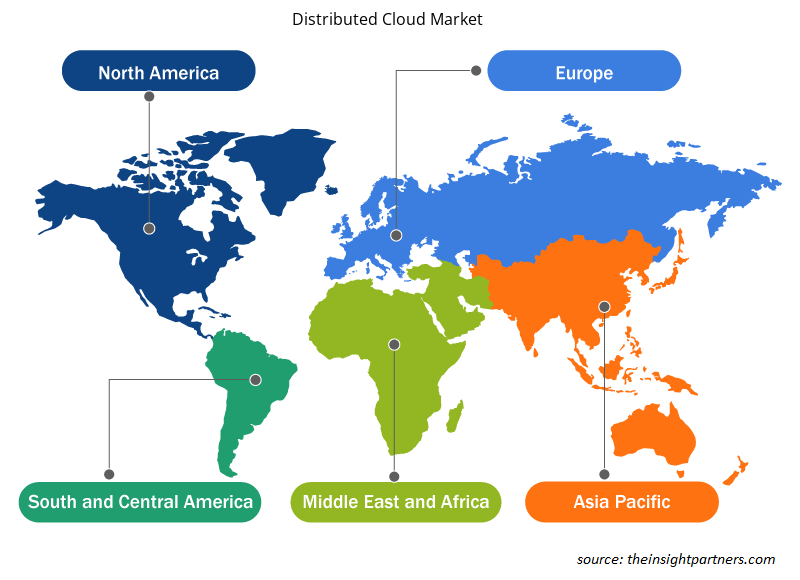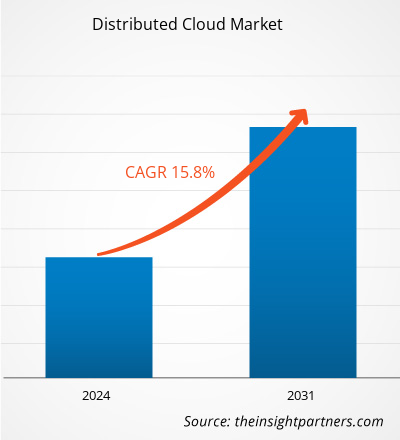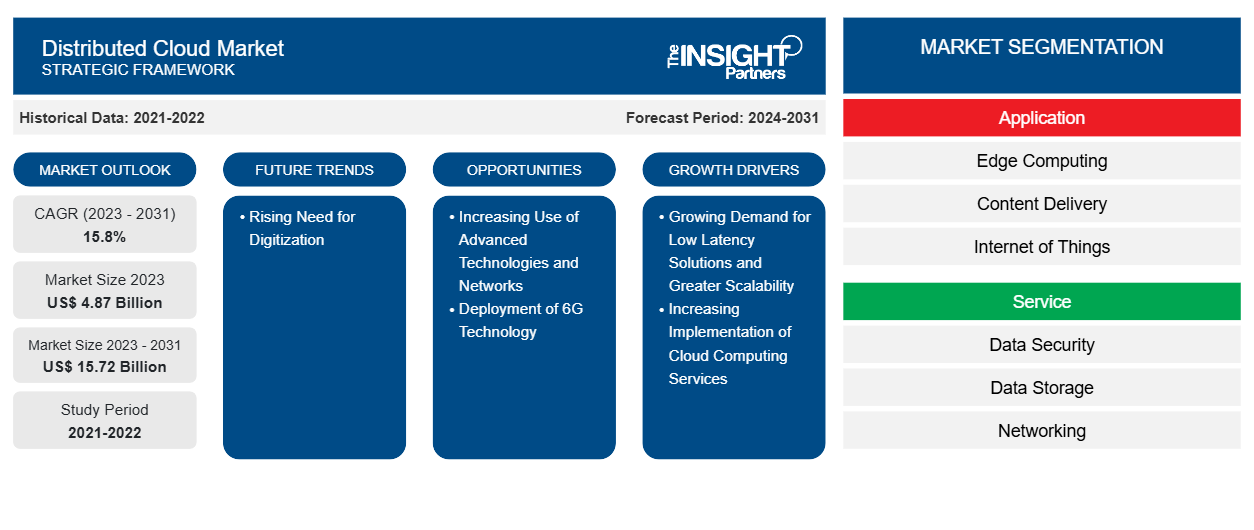분산 클라우드 시장 규모는 2023년 48억 7,000만 달러에서 2031년 157억 2,000만 달러로 성장할 것으로 예상됩니다. 이 시장은 2023~2031년 동안 15.8%의 CAGR을 기록할 것으로 예상됩니다 . 디지털화에 대한 필요성이 증가함에 따라 시장에 새로운 트렌드가 생길 가능성이 높습니다.
분산 클라우드 시장 분석
분산 클라우드 시장 성장은 저지연 솔루션에 대한 수요 증가와 더 큰 확장성에 기인합니다. 분산 클라우드 컴퓨팅은 또한 처리 작업을 최종 사용자에게 더 가깝게 재배치하여 서비스의 응답성을 높입니다. 또한 자동차, 교육, 금융, 소매, 부동산, 농업, 미디어, 엔터테인먼트와 같은 여러 산업에서 클라우드 컴퓨팅 서비스를 점점 더 많이 구현하면서 시장이 성장하고 있습니다. 게다가 6G 기술의 디지털화 및 배포에 대한 요구 사항이 증가하면서 향후 몇 년 동안 분산 클라우드 시장이 활성화될 것으로 예상됩니다. 아시아 태평양 지역에서는 클라우드 컴퓨팅 성장과 투자가 눈에 띄게 증가하고 있으며 퍼블릭 클라우드 서비스 수익도 증가할 것으로 예상됩니다. 중국은 이 지역에서 가장 큰 퍼블릭 클라우드 시장으로 인정받고 있습니다. Alibaba Cloud 및 Huawei 와 같은 최고의 인프라 즉 서비스( IaaS ) 회사는 중국에 본사가 있습니다. 또한 아시아 태평양의 정부는 지정학적 혼란, 사이버 위협 증가, 데이터 보호법 변경, 디지털 무역 정책의 변화로 인해 주권 클라우드 솔루션에 대한 관심을 점점 더 보이고 있습니다 .
분산 클라우드 시장 개요
분산 클라우드의 아키텍처에는 규정 준수 요구 사항과 성능 요구 사항을 충족하는 데 도움이 되는 여러 클라우드가 포함되며, 퍼블릭 클라우드 공급자가 중앙에서 관리하는 동안 엣지 컴퓨팅을 지원합니다 . 사물 인터넷( IoT )과 엣지 컴퓨팅의 성장은 분산 클라우드 배포의 주요 원동력이었습니다. 엣지 위치에서 클라우드로 대량의 데이터를 이동하는 인공 지능(AI) 애플리케이션은 클라우드 서비스가 엣지 위치에 가능한 한 가까워야 합니다. 또한 클라우드 리소스를 엣지 위치 자체로 이동하면 이러한 애플리케이션의 성능이 크게 향상될 수 있습니다.
귀하의 요구 사항에 맞게 이 보고서를 사용자 정의하세요
이 보고서의 일부 또는 국가 수준 분석, Excel 데이터 팩을 포함하여 모든 보고서에 대한 사용자 정의를 무료로 받을 수 있으며 신생 기업 및 대학을 위한 훌륭한 혜택과 할인 혜택을 이용할 수 있습니다.
-
이 보고서의 주요 시장 동향을 알아보세요.이 무료 샘플에는 시장 동향부터 추정 및 예측까지 다양한 데이터 분석이 포함됩니다.
분산 클라우드 시장 동인 및 기회
시장을 선호하기 위한 저지연 솔루션 및 더 큰 확장성에 대한 수요 증가
저지연은 최소한의 지연 시간으로 대량의 데이터 메시지를 처리하도록 개선된 컴퓨터 네트워크입니다. 이러한 네트워크는 빠르게 변화하는 데이터에 대한 거의 실시간 액세스가 필요한 기능을 지원하도록 설계되었습니다. 분산 클라우드 컴퓨팅은 처리 작업을 최종 사용자에게 더 가깝게 재배치하여 지연을 줄이고 서비스의 응답성을 높입니다. 그런 다음 데이터는 중앙 서버가 아닌 로컬에서 관리되어 뛰어난 사용자 경험을 개발합니다. 또한 다양한 회사에서 저지연 요구 사항을 충족하기 위해 분산 클라우드 제품을 제공했습니다. 예를 들어, 2023년 9월 Oracle은 조직의 다양한 요구 사항과 Oracle Cloud Infrastructure( OCI ) 서비스에 대한 증가하는 글로벌 수요를 충족하기 위해 분산 클라우드 제품을 확장했습니다. AWS의 Oracle Database Azure 및 MySQL HeatWave Lakehouse 는 OCI의 분산 클라우드 에 새로 추가된 제품입니다 . 그 결과 기업은 다양한 데이터 프라이버시, 데이터 주권 및 저지연 요구 사항을 해결하면서 어디서나 클라우드 서비스를 배포할 수 있는 유연성이 향상되어 모든 워크로드를 실행하도록 설계된 100개 이상의 서비스에 액세스할 수 있습니다.
6G 기술의 전개
6G는 마이크로초 범위에서 지연 시간을 제공하는 것으로 받아들여집니다. 이를 통해 분산 클라우드 서비스는 증강 현실 (AR), 가상 현실( VR ), 자율 주행과 같은 실시간 처리 작업을 전례 없는 효율성으로 수행할 수 있습니다. 다양한 회사에서 6G 분산 클라우드 및 통신 시스템을 제공합니다. 예를 들어 Next G Alliance( NGA )는 분산 클라우드 및 통신 시스템을 제공합니다. NGA는 이 시스템을 북미 6G 비전을 위해 개발했습니다. 6G 시스템을 장치, 데이터 센터 및 네트워크 노드에서 풍부한 컴퓨팅 및 워크로드 분산을 갖춘 광역 클라우드로 만들려고 합니다. 6G 분산 클라우드 및 통신 시스템은 네트워크 클라우드화 및 엣지 컴퓨팅에서 4G 및 5G에서 달성되지 않은 통합 통신 및 컴퓨팅 시스템 기능을 향한 한 걸음입니다. 따라서 6G 기술의 배포는 예측 기간 동안 분산 클라우드 시장 성장에 여러 기회를 제공할 것으로 예상됩니다.
분산 클라우드 시장 보고서 세분화 분석
분산형 클라우드 시장 분석에 기여한 주요 세그먼트는 애플리케이션, 서비스, 기업, 규모 및 산업 분야입니다.
- 분산 클라우드 시장은 애플리케이션에 따라 엣지 컴퓨팅, 콘텐츠 전송, 사물 인터넷 등으로 구분됩니다. 엣지 컴퓨팅 부문은 2023년에 가장 큰 시장 점유율을 차지했습니다. 엣지 컴퓨팅은 엔터프라이즈 애플리케이션을 로컬 엣지 서버나 IoT 장치와 같은 데이터 소스에 더 가깝게 가져오는 분산 컴퓨팅 개요입니다. 이를 통해 응답 시간이 개선되고, 통찰력이 더 빨라지고, 대역폭 가용성이 향상됩니다.
- 서비스별로 시장은 데이터 보안, 데이터 저장, 네트워킹 및 기타로 세분화됩니다. 데이터 저장 부문은 2023년에 시장에서 가장 큰 점유율을 차지했습니다. 데이터 저장 서비스에는 다양한 클라우드 환경에서 데이터를 안전하게 저장하고 관리하기 위한 조치의 구현이 포함됩니다. 여기에는 데이터 가용성 보장, 데이터 제어 상실, 강력한 데이터 백업 및 복구 전략의 필요성과 같은 문제를 해결하는 것이 포함됩니다.
- 기업 규모 측면에서 시장은 대기업과 중소기업 으로 나뉩니다 . 대기업 부문은 2023년에 시장에서 상당한 점유율을 차지했습니다. 대기업은 분산 컴퓨팅 모델을 활용하여 일반적으로 프레젠테이션, 애플리케이션 및 데이터 계층으로 구조화된 컴퓨터 네트워크에서 비즈니스 프로세스의 다양한 단계를 효과적으로 분산합니다. 대기업은 점점 더 멀티 클라우드 전략을 채택하고 있으며, 컴퓨팅 요구 사항을 여러 클라우드 공급업체에 분산하여 단일 공급업체에 갇히는 것을 피하고 회복성을 강화합니다.
- 산업 수직에 따라 분산 클라우드 시장은 BFSI , 의료, 소매 및 전자 상거래, 제조, IT 및 통신, 에너지 및 유틸리티, 미디어 및 엔터테인먼트, 정부 및 방위 및 기타로 구분됩니다. BFSI 산업은 중요한 과제를 해결하고 혁신을 촉진하기 위해 분산 클라우드 기술의 잠재력을 점점 더 활용하고 있습니다. 이 산업은 사이버 공격 의 다가올 위협 , 데이터 무결성을 유지하면서 고객 데이터 수집을 간소화해야 하는 요구 사항, 엄격한 보안 표준 및 규정을 준수해야 하는 시급한 요구 사항에 지속적으로 직면합니다.
지역별 분산 클라우드 시장 점유율 분석
분산 클라우드 시장 보고서의 지리적 범위는 주로 북미, 아시아 태평양, 유럽, 중동 및 아프리카, 남미 및 중미의 5개 지역으로 나뉩니다.
북미에서는 클라우드 활성화 활동과 클라우드 시장 내 추세가 증가함에 따라 분산 클라우드 시장에서 상당한 성장이 예상됩니다. 분산 클라우드를 사용하면 기업은 추가 비용 없이 모든 크기의 데이터를 전송할 수 있으며 일반 데이터 보호 규정(GDPR)을 준수하는 동시에 데이터 주권을 보장할 수 있습니다. 예측 분석 품질을 향상시키기 위해 데이터를 중앙 집중화하는 AI로 구동되는 데이터 레이크를 제공합니다. 제조, IoT, 머신 러닝, 이미징과 같은 다양한 시나리오에서 사용할 수 있습니다.
다양한 기술과 규정의 조합이 유럽의 분산형 클라우드 컴퓨팅 부문을 정의합니다. 클라우드 기술이 확장되면서 EU 국가 전체에서 클라우드 기술이 다양하게 채택되고 있습니다. EU는 에지로의 전환을 가능하게 하고 통합된 유럽 데이터 공간의 구축을 뒷받침하기 위해 호환되는 클라우드 및 에지 서비스를 만들기 위해 주목할 만한 노력을 기울이고 있습니다. 또한 클라우드 서비스를 위한 유럽 사이버 보안 인증 제도(EUCS)와 같은 수단을 통해 데이터 상주 보장, 운영 인력 통제, 특히 규제되는 부문에서 관할권 문제의 영향 최소화에 중점을 두고 있습니다.
분산 클라우드 시장 지역 통찰력
Insight Partners의 분석가들은 예측 기간 동안 분산 클라우드 시장에 영향을 미치는 지역적 추세와 요인을 철저히 설명했습니다. 이 섹션에서는 북미, 유럽, 아시아 태평양, 중동 및 아프리카, 남미 및 중미의 분산 클라우드 시장 세그먼트와 지리에 대해서도 설명합니다.

- 분산 클라우드 시장을 위한 지역별 데이터 얻기
분산 클라우드 시장 보고서 범위
| 보고서 속성 | 세부 |
|---|---|
| 2023년 시장 규모 | 48억 7천만 달러 |
| 2031년까지 시장 규모 | 157억 2천만 달러 |
| 글로벌 CAGR (2023-2031) | 15.8% |
| 역사적 데이터 | 2021-2022 |
| 예측 기간 | 2024-2031 |
| 다루는 세그먼트 |
응용 프로그램으로
|
| 포함된 지역 및 국가 |
북아메리카
|
| 시장 선도 기업 및 주요 회사 프로필 |
|
분산 클라우드 시장 플레이어 밀도: 비즈니스 역학에 미치는 영향 이해
분산 클라우드 시장 시장은 소비자 선호도의 변화, 기술 발전, 제품의 이점에 대한 인식 증가와 같은 요인으로 인해 최종 사용자 수요가 증가함에 따라 빠르게 성장하고 있습니다. 수요가 증가함에 따라 기업은 제품을 확장하고, 소비자의 요구를 충족하기 위해 혁신하고, 새로운 트렌드를 활용하여 시장 성장을 더욱 촉진하고 있습니다.
시장 참여자 밀도는 특정 시장이나 산업 내에서 운영되는 회사나 기업의 분포를 말합니다. 주어진 시장 공간에 얼마나 많은 경쟁자(시장 참여자)가 존재하는지 그 규모나 전체 시장 가치에 비해 나타냅니다.
분산 클라우드 시장에서 운영되는 주요 회사는 다음과 같습니다.
- 알리바바 클라우드
- 아마존 웹 서비스 주식회사
- 아이비엠
- 신탁
- 마이크로소프트
면책 조항 : 위에 나열된 회사는 어떤 특별한 순서에 따라 순위가 매겨지지 않았습니다.

- 분산 클라우드 시장의 주요 기업 개요를 알아보세요
분산 클라우드 시장 뉴스 및 최근 개발
분산형 클라우드 시장은 1차 및 2차 조사 이후의 질적, 양적 데이터를 수집하여 평가합니다. 여기에는 중요한 기업 간행물, 협회 데이터, 데이터베이스가 포함됩니다. 분산형 클라우드 시장의 몇 가지 개발 사항은 다음과 같습니다.
- Cloud Software Group Inc.와 Microsoft Corp.는 8년 전략적 파트너십 계약을 통해 협업을 심화한다고 발표했습니다. 이 계약은 Citrix® 가상 애플리케이션 및 데스크톱 플랫폼의 출시 협업을 강화하고 통합된 제품 로드맵으로 새로운 클라우드 및 AI 솔루션 개발을 지원합니다. 또한 Cloud Software Group은 Microsoft 클라우드와 생성 AI 역량에 16억 5천만 달러를 투자할 예정입니다.
(출처: Microsoft, 회사 웹사이트, 2024년 4월)
- Oracle, Microsoft, OpenAl은 Microsoft Azure Al 플랫폼을 Oracle Cloud Infrastructure(OCI)로 확장하여 OpenAl에 추가 용량을 제공하기 위해 협력하고 있습니다. OCI의 특수 목적 AI 기능을 통해 스타트업과 기업은 Oracle의 분산 클라우드에서 어디서나 더 빠르고 안정적으로 모델을 구축하고 학습할 수 있습니다.
(출처: Oracle, 회사 웹사이트, 2024년 6월)
분산 클라우드 시장 보고서 범위 및 제공물
"분산 클라우드 시장 규모 및 예측(2021-2031)" 보고서는 아래 영역을 포괄하는 시장에 대한 자세한 분석을 제공합니다.
- 범위에 포함된 모든 주요 시장 세그먼트에 대한 글로벌, 지역 및 국가 수준의 분산 클라우드 시장 규모 및 예측
- 분산 클라우드 시장 동향 및 동인, 제약, 주요 기회와 같은 시장 역학
- 자세한 PEST/포터의 5가지 힘과 SWOT 분석
- 주요 시장 동향, 글로벌 및 지역 프레임워크, 주요 업체, 규정 및 최근 시장 개발 사항을 포괄하는 분산 클라우드 시장 분석
- 시장 집중도, 히트맵 분석, 유명 업체 및 분산 클라우드 시장의 최근 개발 사항을 포함하는 산업 환경 및 경쟁 분석
- 자세한 회사 프로필
- 과거 분석(2년), 기준 연도, CAGR을 포함한 예측(7년)
- PEST 및 SWOT 분석
- 시장 규모 가치/거래량 - 글로벌, 지역, 국가
- 산업 및 경쟁 환경
- Excel 데이터세트
최근 보고서
사용 후기
구매 이유
- 정보에 기반한 의사 결정
- 시장 역학 이해
- 경쟁 분석
- 고객 인사이트
- 시장 예측
- 위험 완화
- 전략 기획
- 투자 타당성 분석
- 신흥 시장 파악
- 마케팅 전략 강화
- 운영 효율성 향상
- 규제 동향에 발맞춰 대응























 무료 샘플 받기 - 분산 클라우드 시장
무료 샘플 받기 - 분산 클라우드 시장